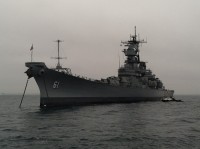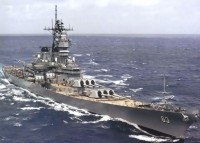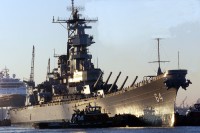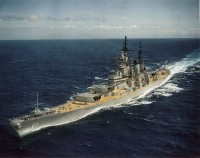Лінійні кораблі класу «Айова»
Основна інформація
Головні розміри
Машина
- 8 * water-tube boilers, 212000 shp (158000 kW)
- 4 * General Electric geared steam turbines
- 4 * screws
- 2 * rudders
Персонал
Бойові сили та засоби
Belt:
- 12.1 in (307 mm) on 0.875 in (22.2 mm) STS
Bulkheads:
- Iowa/New Jersey: 11.3 in (287 mm)
- Missouri/Wisconsin: 14.5 in (368 mm)
Barbettes:
- front 11.6 in (295 mm)
- side 17.3 in (439 mm)
Turrets:
- front 19.5 in (495 mm)
- side 9.5 in (241 mm)
- rear 12 in (305 mm)
- roof 7.25 in (184 mm)
Conning tower:
- 17.3 in (439 mm)
Decks:
- main 1.5 in (38 mm)
- second 6.0 in (152 mm)
- splinter 0.63 in (16 mm) over machinery, 1 in (25 mm) over magazines
1980s:
- AN/SLQ-32(V)
- AN/SLQ-25 Nixie
- Mark 36 SRBOC
World War II, Korea:
- 9 * 16-inch (406 mm)/50 cal. Mark 7 guns
- 20 * 5-inch (127 mm)/38 cal. Mark 12 guns
- 80 * 40 mm (1.57 in)/56 cal. Bofors guns
- 49 * 20 mm (0.787 in)/70 cal. Oerlikon cannons
Cold War, Gulf War additions:
- 9 * 16-inch (406 mm)/50 cal. Mark 7 guns
- 12 * 5-inch (127 mm)/38 cal. Mark 12 guns
- 32 * BGM-109 Tomahawk
- 16 * RGM-84 Harpoon
- 4 * 20 mm (0.787 in) Phalanx CIWS
All Bofors 40 mm and Oerlikon 20 mm and 8 * 5"/38 cal Mark 12 removed
World War II:
- 3 * Vought OS2U Kingfisher/Curtiss SC Seahawk floatplanes
Korea/Vietnam:
- 3 * helicopters
Cold War/Gulf War:
- 5 * RQ-2 Pioneer Unmanned aerial vehicles
The Iowa-class battleships were a class of six fast battleships ordered by the United States Navy in 1939 and 1940 to escort the Fast Carrier Task Forces that would operate in the Pacific Theater of World War II. Four were completed; two more were laid down but canceled in 1945 at war's end, and both hulls were scrapped in 1958. Like other third-generation American battleships, the Iowas followed the design pattern set forth in the preceding North Carolina-class and South Dakota-class battleships, which emphasized speed in addition to secondary and anti-aircraft batteries. Based on wartime experience, they were to serve as fast escorts for Essex-class aircraft carriers.
The four Iowa-class ships were the last battleships commissioned in the US Navy. All older US battleships were decommissioned by 1947 and stricken from the Naval Vessel Registry (NVR) by 1963. Between the mid-1940s and the early 1990s, the Iowa-class battleships fought in four major US wars. In World War II, they defended aircraft carriers and shelled Japanese positions. During the Korean War, the battleships provided naval gunfire support (NGFS) for United Nations forces, and in 1968, New Jersey shelled Viet Cong and Vietnam People's Army forces in the Vietnam War. All four were reactivated and modernized at the direction of Congress in 1981, and armed with missiles during the 1980s, as part of the 600-ship Navy initiative. During Operation Desert Storm in 1991, Missouri and Wisconsin fired missiles and 16-inch (406 mm) guns at Iraqi targets.
The Navy spent about $1.7 billion, from 1981 through 1988, to modernize and reactivate the four Iowa-class battleships. Costly to maintain, the battleships were decommissioned during the post-Cold War draw down in the early 1990s. All four were initially removed from the Naval Vessel Register, but the United States Congress compelled the Navy to reinstate two of them on the grounds that existing NGFS would be inadequate for amphibious operations. This resulted in a lengthy debate over whether battleships should have a role in the modern navy. Ultimately, all four ships were stricken from the Naval Vessel Register and released for donation to non-profit organizations. With the transfer of Iowa in 2012, all four are part of non-profit maritime museums across the US.
Кораблі4
- Коментарі
 uk
uk en
en ru
ru
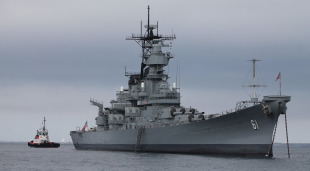
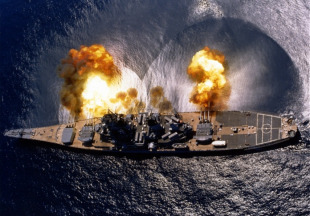
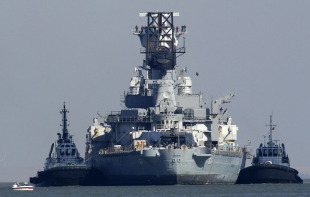

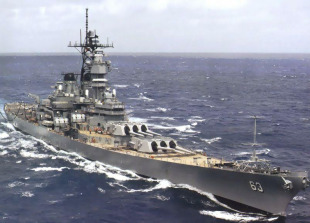

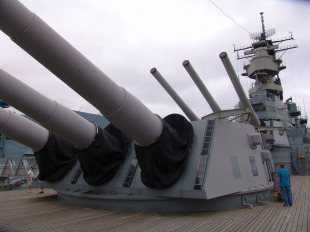

 Військово-Морські Сили США
Військово-Морські Сили США